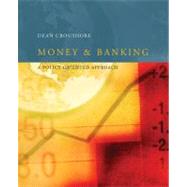
| Preliminary Contents | |
| Introduction to Money and Banking | |
| What's in This Text? | |
| Ten (Surprising) Facts Concerning Money and Banking | |
| Money and the Financial System | |
| The Financial System and the Economy | |
| Financial Securities | |
| Matching Borrowers with Lenders Financial Markets | |
| The Financial System | |
| Application to Everyday Life: What Do Investors Care About | |
| Money and Payments | |
| How We Use Money | |
| Counting Money Application to Everyday Life:What Do You Do with Your Change | |
| Present Value | |
| The Present Value of One Future Payment | |
| The General Form of the Present-Value Formula | |
| Using Present Value to Make Decisions | |
| Using the Present-Value Formula to Calculate Payments | |
| Looking Forward or Looking Backward at Returns | |
| Application to Everyday Life: How to Negotiate a Car Lease | |
| The Structure of Interest Rates | |
| What Explains Differences in Interest Rates | |
| The Term Structure of Interest Rates | |
| The Term Premium | |
| The Yield Curve and the Business Cycle | |
| Policy Perspective: Can the Term Spread | |
| Help Predict Recessions | |
| Real Interest Rates | |
| What Are Real Interest Rates | |
| Real Present Value | |
| What Affects Real Interest Rates | |
| Application to Everyday Life: How Inflation and Taxes | |
| Reduce Investors' Returns | |
| Stocks and Other Assets | |
| The Stock Market | |
| How Can an Investor Profit in the Stock Market | |
| Application to Everyday Life: Comparing Stocks with Bonds and Other Financial Investments | |
| Fundamentals of Banking | |
| How Banks Work | |
| The Role of Banks | |
| How Do Banks Earn Profits | |
| Policy Perspective:Should the Fed | |
| Let Reserve Requirements | |
| Be Swept Away | |
| Government's Role in Banking | |
| Regulation of Banks Supervision of Banks | |
| Policy Perspective: Should Mergers of Big Banks Be Allowed | |
| Macroeconomics | |
| Economic Growth and Business Cycles | |
| Measuring Economic Growth Business Cycles | |
| Application to Everyday Life: How Does Economic Growth | |
| Affect Your Future Income | |
| Modeling Money | |
| The Atm Model of the Demand for Cash | |
| The Liquidity-Preference Model | |
| The Dynamic Model of Money Policy Perspective: Using Models of Money | |
| Demand in Practice | |
| The Aggregate-Demand/Aggregate-Supply Model | |
| A Model of Aggregate Demand and Aggregate Supply | |
| Analyzing Policy Using the Ad-As Model Large, Structural Macroeconomic Models | |
| Policy Perspective: Did Large Macro Models | |
| Mislead Policymakers in the 1970s | |
| Modern Macroeconomic Models | |
| Dynamic Models | |
| Dynamic, Stochastic, General-Equilibrium Models | |
| Statistical Models of the Economy Policy | |
| Perspective: Do Modern Macroeconomic Models | |
| Have Any Value for Policy | |
| Economic Interdependence | |
| The International Business Cycle | |
| Exchange Rates Policy Perspective: How Independent Should a Country Be | |
| Monetary Policy | |
| The Federal Reserve System | |
| Federal Reserve Banks | |
| The Board of Governors | |
| The Federal Open Market Committee Policy Perspective: Should the Federal Reserve Be So Independent | |
| Monetary Control | |
| Monetary Control Money Creation and Destruction by the Fed and by Banks | |
| Realistic Money Multipliers | |
| The Fed's Tools for Changing the Money Supply | |
| The Market for Bank Reserves | |
| Policy Perspective: Should the Fed Pay Interest on Reserves | |
| Monetary Policy: Goals and Trade-Offs Stabilization Policy | |
| Goals of Monetary Policy | |
| The Fed's Objective Function Policy | |
| Perspective: the Phillips Curve | |
| Rules for Monetary Policy Rules Versus Discretion Money-Growth Rules | |
| The Taylor Rule Inflation | |
| Targeting Policy Issue: Why Don't Policymakers Follow Rules? | |
| Table of Contents provided by Publisher. All Rights Reserved. |
The New copy of this book will include any supplemental materials advertised. Please check the title of the book to determine if it should include any access cards, study guides, lab manuals, CDs, etc.
The Used, Rental and eBook copies of this book are not guaranteed to include any supplemental materials. Typically, only the book itself is included. This is true even if the title states it includes any access cards, study guides, lab manuals, CDs, etc.